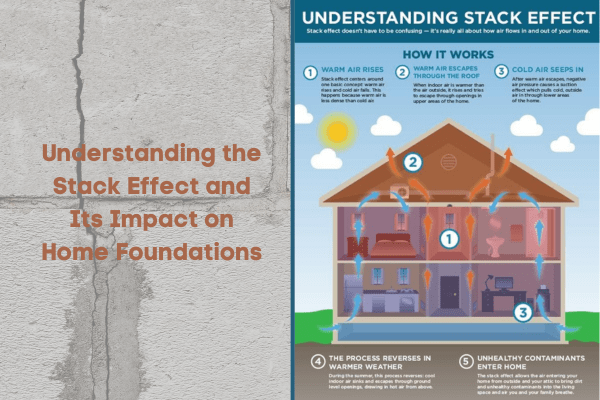When it comes to maintaining a sturdy and stable home foundation, it’s crucial to be aware of various factors that can influence its integrity. One such factor is the stack effect. Although often associated with energy efficiency, the stack effect can also affect a home’s foundation.
A third of American households struggle to pay off high energy bills. If you want to lower these expenses, energy conservation is a great place to start. But it can only do so much if your home suffers from the stack effect. The stack effect is a major cause of energy inefficiency in homes with high ceilings or multiple floors. Crawl spaces in bad condition worsen its impact. And if it’s bad enough, allergens and mold in your crawl space will infiltrate your home.
Does your heater or air conditioner struggle to keep your home comfortable? It could result from the stack effect. If you believe you’re affected, read on for a proper diagnosis and preventative measures.
How Does the Stack Effect Work?
During colder months, warm air rises from the lower levels of a building due to a temperature differential between indoor and outdoor spaces. As warm air escapes through upper-level openings like windows, vents, or gaps, it creates negative pressure within the structure. This negative pressure can lead to air being drawn into the building from the foundation or other lower-level openings.
Understanding the Stack Effect
From windows to chimneys to crawl spaces, the fact of the matter is no home is a closed system. Outside air can slip in through these access points and change the internal air temperature.
When things get too cold, you adjust the thermostat to compensate and kick on the heater. This will lead to the unwanted stack effect.
Keeping in mind that hot air rises, it will travel to the upper levels of your home and escape through gaps in the attic, windows, or floorboards. The absence of this upward air creates a vacuum in its wake, pulling in heavier, colder air through the leaks in your crawl space and ground-level windows.
If you continue to change the temperature in your home, this cycle of air will continue. And it’s not just something that happens during the wintertime.
Let’s say you’re running the HVAC in the middle of July. As the air drops in temperature, it also becomes heavier and sinks to the bottom of your home, seeking an avenue of escape. When the cold air leaves through the crawl space, a vacuum in the upper regions of your house will then pull hot air through the attic and windows.
In short, you can experience a stack effect during any season. The direction of the airflow is the only thing that changes depending on the time of year.
Stack Effect and the Impact on Home Foundations
If left unchecked, the stack effect will make it impossible to regulate the temperature in your home. As your heater or air conditioner works overtime, it will perpetuate the airflow without drastically improving the home’s internal temperature. This can lead to significant increases in your overall energy bill. By running your temperature-control devices more often than necessary, they’ll also accrue additional wear and tear.
Worst of all, the stack effect is a serious health concern. During winter, outside air travels first through your home’s crawl space and then into the rest of your home.
And your crawl space isn’t the most sanitary part of the home. It’s a nesting ground of microbes and allergens, which will then ride the air currents into the living areas of the household. Mold spores can then deposit themselves in moist areas around your home, such as the kitchen and bathroom, leading to mold growths.
While not an ideal solution, crawl space cleaning and encapsulation can help reduce the allergens and spores that enter your home.
The stack effect can have several effects on home foundations, potentially leading to various issues:
Moisture Infiltration: As air is drawn into the lower levels of a building due to the stack effect, it can carry moisture and outdoor contaminants with it. This increased moisture level can cause foundation materials, such as concrete or masonry, to deteriorate over time.
Condensation and Mold Growth: When warm, humid air enters the cooler basement or crawl space, it can result in condensation. Excessive moisture accumulation in these areas can lead to the growth of mold and mildew, which can further compromise the foundation’s integrity and affect indoor air quality.
Structural Shifting: Changes in temperature and moisture levels caused by the stack effect can cause the soil beneath the foundation to expand or contract. These fluctuations may result in soil movement and subsequently lead to foundation settlement or shifting. Over time, this can cause cracks in the foundation and potentially compromise the overall structural stability of the home.
Preventing and Mitigating the Effects
To mitigate the impact of the stack effect on home foundations, consider the following preventive measures:
Sealing and Insulation: Properly seal gaps and cracks in the foundation, walls, and windows to minimize air infiltration. Additionally, insulating the basement or crawl space can help regulate temperature and reduce the potential for condensation.
Seal the Attic: Your attic takes a beating from inclement weather. It’s also not an area you keep your eyes on very often, which means problems can spring up without you knowing. In the attic, look for cracks along the joints, wires, and plumbing. When you find an open space, seal it with caulk. You must use a foam solution to plug some larger holes. Insulation can play a significant role in keeping indoor air. If you believe your attic is lacking insulation or needs more, it may be in your best interest to make a change.
Seal Your Crawl Space: The crawl space is the worst offender in the stack effect chain. Cracks in the foundation can be difficult for homeowners to uncover. Not to mention, they don’t have the tools or experience needed to make the repair.
Examine the Windows: Windows and doors on any level of your home are some of the most common culprits of leaks. Checking the windows requires you to examine both the indoor and outdoor portions of the frame. You’re looking for old caulking or joints where the wood connects without sealant.
Ventilation and Dehumidification: Improve air circulation and control humidity levels in the basement or crawl space by installing vents or a dehumidifier. This can help reduce moisture and prevent mold growth.
Foundation Maintenance: Regularly inspect the foundation for signs of cracks, settlement, or shifting. Address any issues promptly by consulting a professional foundation contractor to prevent further damage.
Landscaping and Drainage: Ensure proper grading and landscaping around the foundation to direct water away from the home. Proper drainage systems, such as gutters and downspouts, can also help prevent excessive water accumulation near the foundation.
Test to see if your home suffers from the stack effect
Some leaks are hidden deeper in the window frame and invisible to the naked eye. For an old, low-tech test, pull out a wispy stick of incense and close all the doors and windows. Disable any temperature-changing appliances, then turn on an exhaust fan or two. This replicates the stack effect. By holding the incense stick near windows and doors, the smoke will waft inward, pushed along by the air coming into your home through hidden cracks.
Consult with the Foundation and Crawl space Professionals
Understanding the stack effect and its potential impact on home foundations is essential for homeowners looking to maintain a stable and secure foundation. By implementing preventive measures, such as sealing gaps, controlling moisture levels, and performing regular maintenance, you can mitigate the effects of the stack effect and help ensure the long-term integrity of your home’s foundation. Consulting with professionals in foundation repair and maintenance can provide further guidance and expertise in addressing specific concerns related to your home’s foundation.
If you believe the stack effect is occurring in your home, it’s time to call BAM basements Des Moines crawl space professionals. We’ll repair your home’s damaged foundation and help you breathe easier.
We would welcome the opportunity to help you with all your Foundation and Crawl space needs. BAM Basements and Masons of Des Moines is your premier egress window company serving the Des Moines, Iowa area. If you’re located in Des Moines, Ankeny, Bondurant, Altoona, Pleasant hill, Ames, Adel, Waukee, Indianola, Grimes, Urbandale, Johnston, West Des Moines, or the surrounding areas, we’re the place to call. We can help you avoid costly and stressful foundation repair mistakes, by giving you a customized solution that’s going to work for you and your home in the long term. BAM Basements and Masons of Des Moines is a professional and locally owned and operated state-registered contractor. Affordable honest upfront pricing, no hidden costs, offer free estimates and limited lifetime warranties.


